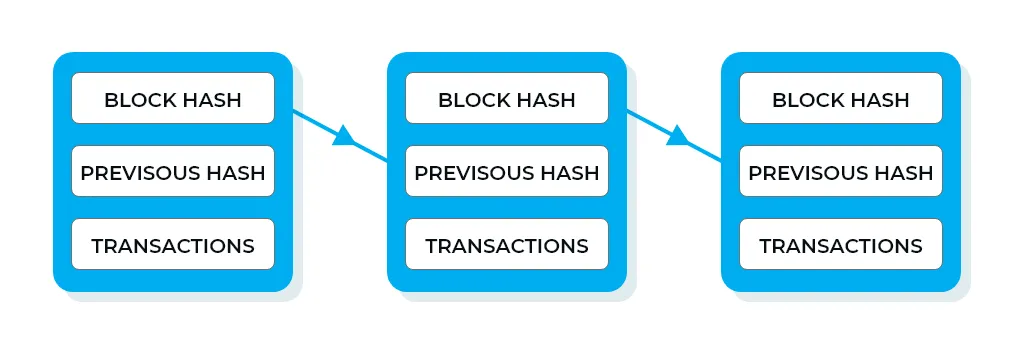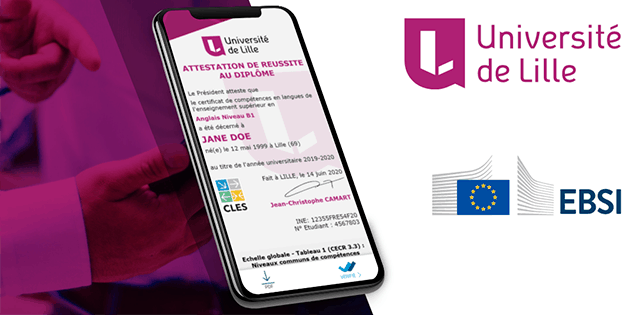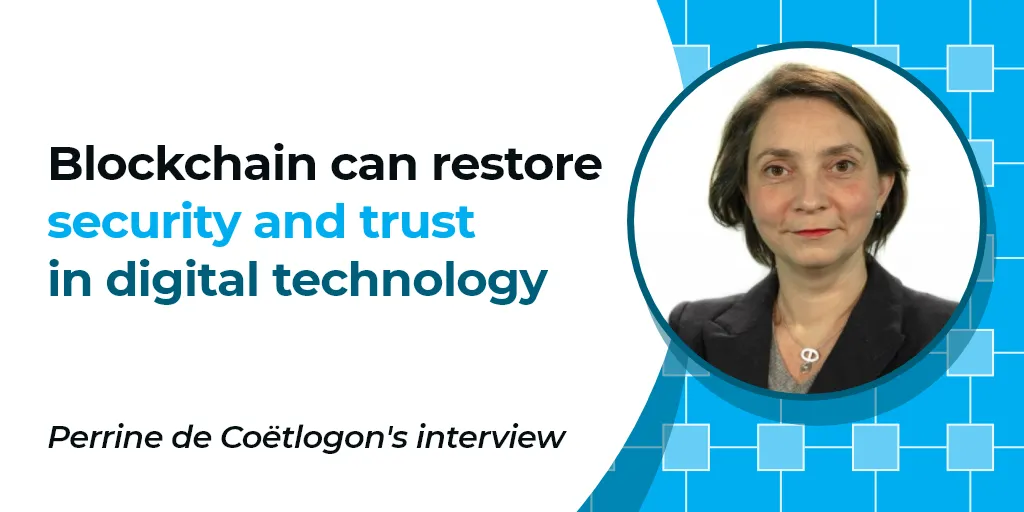Blockchain technology is fueling as many promises as it raises concerns, yet a white paper published this summer urges public actors to embrace this technology that came to light in 2008.
Interview with Perrine de Coëtlogon, head of a pioneering blockchain project at the University of Lille, Board Member at Open Education Global and French representative at the European Blockchain Partnership – EBSI. Interview conducted in French by Acteur Public.
First and foremost, can you explain what blockchain is?
It’s not easy to define blockchain because it is a key infrastructure layer in itself and a completely imperceptible component at the same time. It’s important to understand that blockchain harkens back to two major human innovations: ledgers and currencies. Registers (ledgers) might not seem very interesting on the surface, but it’s worth noting that writing was invented around five thousand years ago to keep reliable and permanent data on people (civil status) or goods (land registries, ship cargoes traceability, etc.). People who knew how to read and write could use these tools in their daily lives. They were in minority, but gained the trust of the entire community, and as dependable third parties, they kept these registers to ensure their authenticity, thus guaranteeing legality and peace.
And this is still the case today for all registers throughout the world. The limitations of barter have gradually led humans to create abstract values for trade, using cereals, shells, bank drafts, etc. For the last forty years, financial transactions have become dematerialized, turning into a mere line entry on a bank register. Blockchain technology gives us the opportunity to think about yet another major evolution, the digital transformation of registers and money. With smart contracts, one can also decide when and/or under what conditions a transaction should be made and recorded. This brave new world leverages the full potential of distributed computing systems and cryptography.
Blockchain technology as an opportunity to decentralize
Because of a cryptocurrency like bitcoin, blockchain has gained a rather nefarious reputation, in direct opposition to state and traditional institutions…
After the 2008 financial crisis, Satoshi Nakamoto wrote a white paper that would set the groundwork for the creation of an open ledger system and ultimately bitcoin. He felt that trusted third parties such as banks had not played their dutiful role and were responsible for the crisis. He wanted to give citizens the power to issue a currency and the opportunity to decentralize finance. This desire was a direct challenge to the sovereignty of states and central banks in issuing money. But because this project immediately attracted investment from the very financial sectors it vowed to combat, it may give the impression that these are the same people who conspired to bet on cryptocurrencies, appropriating their libertarian principles as a playground for even more speculation.
Moreover − and this was not foreseen by Satoshi Nakamoto − the computer system used by cryptocurrencies such as bitcoin that relies on proof-of-work validation requires huge amount of energy to operate, which further damages blockchain’s image. But it’s worth pointing out that this is not the case for many other systems, especially the so-called consortium or private blockchains. So I’d say it would be regrettable not to take an interest in this field, as it’s precisely this lack of confidence that gives rise to numerous relevant ideas and new international standards.
“From the user’s perspective, the goal is to control a portfolio of secure and authenticated data, even when it is issued by public authorities.”
How is the public sector impacted by blockchain technology?
The white paper we published aims to serve as a guide to assess in which cases blockchain technology is relevant. It is particularly useful when numerous stakeholders are involved, do not necessarily have the same status and need to transfer data securely using a shared register. Such a requirement is nothing new, but blockchain is opening a new frontier in terms of authenticity and security of information. From the user’s perspective, the goal is to control a portfolio of secure and authenticated data, even when it is issued by public authorities. Whereas for public services or their delegate, the objective is to share a tool to accelerate and streamline processes.
What use cases for blockchain?
In 2018, a partnership was launched at the European level to create a turnkey European Blockchain Service Infrastructure (EBSI) to build transnational public services. It has been developed using open-source technology without any of the issues related to mining and energy consumption. Several projects are currently undergoing testing, most notably one relating to self-sovereign identity and diplomas, which I will discuss later, and another on the traceability register. In this framework, we want to test a device for legal process visualization that allows for official documents or contracts to be legalized or apostilled in a different legal system. This is part of a modernization process that is of great interest to the Hague Conference on Private International Law because the system based on a conventional software introduced back in 2006 wasn’t convincing enough.

The white paper refers to other ongoing experiments at business level: one by IN Groupe (Imprimerie nationale) where using blockchain for authentification could enable UNICEF to give proof of existence, and therefore a digital ID, to the 166 million children born without an identity, particularly in developing countries. And another by Orange, as within the framework of AGDataHub, where blockchain technology would make it possible to certify and link farmers’ identity to their farms.
What about the University of Lille, which is carrying the European fr.EBSI project for the Interministerial Digital Department (Dinum)?
The University of Lille is bound to become the first French public actor to test the European blockchain service infrastructure for the Interministerial Digital Department, within the framework of the European fr.EBSI project, focusing on the “Diploma” use case. Pierre Boulet, Vice President of Digital Transformation and member of the European Blockchain Partnership’s technical group, believes that this initiative represents a world first at this scale: the University of Lille will be home to nearly 80,000 students by 2022! It is a great challenge to undergo transformation while innovating through the implementation of a system for issuing and managing verifiable digital achievement certificates for diplomas, as the whole operation involves 18 staff members from 5 departments and 2 partners: public interest group Renater, and the company Blockchain Micro Credentials Data − BCdiploma.

Until now, students have received their exam results in PDF format. The original diploma is considered a parchment: it is printed by IN Groupe on forgery-proof paper and signed by three people within six months. Students must pick it up or pay for registered mail delivery. Most often, they use an easily falsifiable paper or scanned copy in their job seeking process. In both cases, the added value of the original diploma is lost.
“Today, the main obstacle to the launch of public services on blockchain is infrastructure. Most public players are reluctant to invest money and efforts into it.”
How will blockchain technology impact students?
The French Ministry of Education has deployed its Diplome.gouv.fr platform, which centralizes all issued diplomas. But it remains incomplete, as the ministry could not find a solution to fetch achievement certificates from universities’ archives, which operate independently. Blockchain technology and blockchain micro credentials could provide a great solution to overcome this issue and support the sharing of authentic data. With the DemattestUlille internal digital transformation project – which has been validated by the Minister of Higher Education, Research and Innovation in the framework of the university’s strategic management dialogue − and the fr.EBSI project, students will receive a permanent link to a verifiable and forgery-proof Web document within 48 hours, which they can then present to an employer along with an English translation, all in a computer format that is currently being rolled out on a global scale: digital verifiable credentials.

BCdiploma also provides a highly innovative solution on the protection of personal data because students’ data is encrypted in the blockchain. The process will kick off with a test phase for 2020 diplomas before gradually generalizing to the issuance of certificates for the current year across the university’s 11 major departments. And at a very reasonable cost! Today, the service is based on delegated blockchain, but it is intended to integrate within the EBSI network in the near future.
Your white paper encourages public administrations to take the plunge and commit to blockchain technology. Does this solution truly apply to all of them?
The white paper was written to highlight the benefit of blockchain for the public sector. It prompts readers, and in particular CIOs, to consider its potential applications and whether or not it could solve issues within their specific scope. I believe the more diverse stakeholders and beneficiary users are involved, the stronger the system will become in allowing data to flow smoothly and with complete trust.
What are the conditions for a successful blockchain project?
To implement a successful blockchain project, it is key to set up genuine governance between the various stakeholders because all difficulties in this type of project are upstream (we call it technical governance). For instance, it is necessary to invent or reinvent APIs and data dictionaries to decide which decisions the system can make automatically, and understand that the traceability of the data path will make it possible to identify the stakeholder responsible for its mismanagement. It also requires deciding who shares what data, and who has the right to read it.
Today, the main obstacle to the launch of public services on blockchain is the infrastructure. Most public players are reluctant to invest money and efforts into it, while private players aren’t even considering the long-term profitability of such a project. We are in the process of setting up a consortium to bring together French public and private players in order to implement a ready-to-use infrastructure, which would help us overcome this reluctance and facilitate the deployment of blockchain. We will certainly have the opportunity to discuss this again with Acteurs publics!
Source: Interview published in French by Acteur Public, EMILE MARZOLF, on September 2, 2021
Learn more about Blockchain GDPR.
[title[Blockchain in Public Sector: Perrine de Coëtlogon’s Vision]] [description[Blockchain offers the necessary guarantees in terms of security and transparency to become a relevant solution for public institutions and education.]]